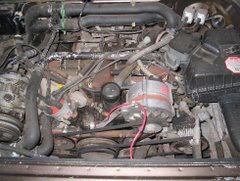Sample exchange:
Bob (of Electric Vehicles of America, our supplier): I have had a number of emails and phone call with Brian Sullivan at Advanced DC Motors. He reviewed the pictures and concluded that the motor will be fine if the brush springs are placed back on the brushes. The armature looks fine. So let's do it. Let's put the 8 springs back where they should be and run on a 12V battery to see how it is.
Bill: That armature has what it looks like mica seeping from between the commutator and above the segments. Plus, the commutator is black. In my humble opinion the motor should be replaced. I will do what you and Advanced suggest, I don't like it but let's see if it will spin with the brushes in place.
Brian (of Advanced DC Motors): As I stated previously, we would pay for the freight to return this motor only if there is a defect found in materials or workmanship. This brush spring fiasco is not a defect that I will accept. If the brushes were returned to their correct position and the motor still will not run, there may very well be a defect within the motor. The only way that I can tell that is to evaluate it and I can't do that if your customer is unwilling to take a chance.
Happily, this discussion has been resolved -- but unhappily, the time-frame required to ship the motor back for diagnostic testing will prohibit us from displaying the van at the Pennsylvania Alternative Energy Festival in Kempton, PA next weekend. Instead, we will bring our other EV, the 1991 Dodge Colt conversion. I will still present on the process of converting the van. I'm sorry we won't be able to show it off, but we are all reminding ourselves that every problem is a learning opportunity!
 Interior of motor showing springs on the right touching the sides of the brushes (they are supposed to rest on top of the flat metal things in the middle), and the blackened commutator underneath.
Interior of motor showing springs on the right touching the sides of the brushes (they are supposed to rest on top of the flat metal things in the middle), and the blackened commutator underneath.All right, onto the topic at hand: learning how to prepare a large, heavy object for shipping via motor freight.

We had the motor, the pallet, and a choice between bolting the motor onto the pallet and covering it with a box, or wrapping and boxing it and then strapping the box to the pallet. We had a nice leisurely discussion of the pros and cons of each method, during which I demonstrated my superpower of starting out on one side of a debate and then ending up on the other, while Bill demonstrated his superpowers of infinite patience and good humor! In the end we went with bubble wrap, newspaper and fiberglass strapping tape.

Packing a large, heavy, cylindrical object in bubble wrap turns out to be a rather amusing process. Every time we rolled the motor, all the bubbles went pop-pop-pop-pop-pop, making us fear that we were effectively packing the thing in saran wrap, but eventually some kind of critical mass was achieved and we agreed it was well-padded.
In the grand tradition of Jenny getting other people to do work on van-related projects while she takes the picures, I even had my 5-year-old daughter on the job.
Finally we had the thing boxed up ...
 and strapped firmly to the pallet. (If I had the technical capability I'd insert some songs from the terrific mix we were listening to here: Bill K's Music to Strap Boxes By).
and strapped firmly to the pallet. (If I had the technical capability I'd insert some songs from the terrific mix we were listening to here: Bill K's Music to Strap Boxes By). The motor will be shipped out on Monday. Of course, I'll keep you posted on the van's return to functionality!
The motor will be shipped out on Monday. Of course, I'll keep you posted on the van's return to functionality! In the meantime, a recent comment posted by a reader inquired whether the alignment jig we used to match motor and transaxle would be available for loan or rental. It certainly is! Here's a slightly blurry picture of it -- perhaps we'll develop a side business of renting out such items for EV converters, since for some reason they don't come with the Electric Vehicles of America kit.
In the meantime, a recent comment posted by a reader inquired whether the alignment jig we used to match motor and transaxle would be available for loan or rental. It certainly is! Here's a slightly blurry picture of it -- perhaps we'll develop a side business of renting out such items for EV converters, since for some reason they don't come with the Electric Vehicles of America kit.I'll be back next week with a report on the Alternative Energy Festival. Thanks for following along, everybody.






1 comment:
Oh no...I hope you get those engine woes sorted out Jenny!
-Kevin
Post a Comment